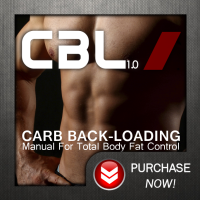As a family woman, Julia has to balance the nutrition needs of her training against the monstrous appetites of her two growing children, who still want to eat a normal breakfast and have a balanced family dinner. I also noted that she trains in the morning, a non-ideal training time for Carb Back-Loading, and she has still been able to develop her strength while getting down to the leanest she’s ever been.
So I asked Julia if she’d write a little something to appear here on DangerouslyHardcore.com, about her experiences starting Carb Back-Loading back at the beginning of 2011, how she worked Carb Back-Loading into her everyday life and how she now feels about it.
What she sent back was phenomenal. I even asked her for cute pics of her kids and she found these great messy-face photos; so yes, blame me for screwing up DH.com. If the cute kids are offensive to you, skip that and watch Julia throwing some serious weights around.
Julia Ladewski: 9 Months (and still counting) on Carb Back-Loading
I thought my husband was crazy when he first described doing Carb Back-Loading to me. He claimed that many strength athletes were getting pretty good results with losing body fat and maintaining (or building) strength.
Pfft. I thought this was another “low-carb” plan, which I had tried before and wasn’t too fond of. And I was not about to partake in anything of the sort again.
My husband had been back-loading for about a week. I took the time to read up on it and learn a little more. Then, I finally gave in and said, “Fine… I’ll give it a shot.”
Three short weeks turned to 9 months in a flash, and I never looked back. Below are my findings.
Getting Started
The first few days of skipping breakfast were a little difficult. Had coffee with heavy cream, but that was it. The hunger pangs were a little annoying because I was used to shoving a bagel or a bowl of oatmeal, or eggs and toast in my face. After a few days, it was totally manageable. I got into a groove of what fits my schedule and life and it’s been more than easy to stick with it.
My typical day looks something like the following:
- 7am – Coffee w/ heavy cream and stevia
- Noon – Lunch (ONE of the following: Large salad w/ chicken breast, Eggs
& bacon, Chicken breast w/ veggies, Grass-fed burger (no bun) w/
roasted broccoli, Grass-fed steak w/ roasted brussel sprouts, etc.) - 3pm – Snack (Protein Shake and Almonds)
- 5pm – Snack (Fruit, yogurt, or hummus)
- 7-8pm – Dinner (ANYTHING! Could be pasta, tacos, chili, pancakes, soup & sandwich, etc)
- 9-10pm – Snack (Depending on what dinner was, what I felt my caloric intake was and if I trained that day or not, I may or may not have a snack. If I do, it’s usually something sweet (like chocolate) and a protein shake. Oh, and ice cream once a week.)
Keeping It Going
I thought for sure I’d get sick of it. I mean, I had tried low-carb stuff before and ended up getting sick of it (more on that below).
But carb back-loading is so easy to maintain.
Think about it: you have coffee for breakfast, a good healthy lunch, a decent snack and then whatever you want for dinner.
Sounds like some scammy infomercial for a rapid weight loss diet, huh? But that is soooo not the case. And when you understand the WHY behind it all (not eating carbs in the morning and eating carbs at night), it makes so much more sense and makes it easier to make the right decisions based on how you want to feel and perform the next day.
Family Life
Prior to starting carb back-loading in March 2011, I had fallen into the popular “Mom” diet. You know, the one where you eat the same things that the kids eat (because it’s just easier) or you have their leftovers so you don’t waste any food.
Without even realizing it, I was eating tons of processed junk and hardly any vegetables. Sure, I may have gotten lazy in what I made the kids too — which I fully realized once I started eating this way. But sometimes I would make the kids veggies or fruit, but not want to eat it myself.
In switching myself to Carb Back-Loading, here is what the family diet became:
- Breakfast – I don’t have my kids back-load and they do still eat breakfast. Mostly oats, eggs, toast, yogurt and fruit and occasionally cereal.
- Lunch – My kids either eat what I’m eating for lunch (a protein and veggie) or they eat a typical “kid” meal (sandwich, a veggie or fruit and pretzels/yogurt/almonds). As you can see, Mommy couldn’t eat the same lunch as them anymore. When I started back-loading, it forced me to make a ton of veggies for lunch. Of course I ate them… but so did the kids.
- Dinner – Eating this way (back-loading) allowed us to still have family dinner time without having to make any special accommodations for anyone on a special diet. We eat the same thing and we eat together.
Being Prepared
While I wouldn’t say there were too many bumps in the road, I do have to be prepared and have some snacks ready and available at work — which, to be honest, is a good thing. I think snacking is where a lot of people get caught up in eating what’s at the office or stopping by the vending machine thinking one donut or a candy bar is ok. But on a daily basis, that adds up! (Not to mention… it’s JUNK!)
Before back-loading, I might eat a bag of baked chips or crackers or pretzels for a snack. Now, I eat almonds, protein shakes, or hard-boiled eggs — healthy snacks I should be eating anyway.
Why? Because I. Feel. Better.
I love back-loading way more than any other nutritional protocol I’ve tried in the past. I don’t feel as restricted and can still have some of the things I enjoy. At the same time, I feel that I’m making better choices, even during my back-loading time frame when I could technically eat what I want.
- While I typically don’t like nutrition protocols that “force” you to eat certain foods, I don’t feel “forced” to eat anything. I mean, really, I should be eating veggies anyway. So eating this way takes care of that. Plus, I’ve found some new veggies/recipes that I love!!!
- I usually get a sweet tooth at night. And while I could eat an entire half gallon of ice cream, I make the choice to have a protein shake and/or a bowl of oatmeal before digging in. But again, I don’t feel restricted or locked down… I can still make the choices I want.
- Here’s the big one… a REALLY BIG TAKE AWAY… I. Feel. Better.
I feel better about the choices I make. I feel better about the foods I’m eating (no more processed junk). I feel better energy-wise. I’m not hungry. I don’t crash at 2:00 in the afternoon because I’ve carbed up all morning. I’m strong(er) and my training rocks. I feel better about the foods I’m feeding my kids.
- I don’t let eating this way control my life. It guides me in the direction I want to go by eating the foods I should be eating and love. When I have a family function to go to, I adjust accordingly. Also, 99% of the functions I attend are in the afternoon or evening anyway.
- Learning how my body responds to carbohydrates has been a real eye-opener. I never associated the afternoon fatigue, hunger and bloat to the carbs I was eating in the morning. Also learning how to time my carbohydrates has played a huge role in keeping my strength and energy levels up for the intense training sessions.
- I train in the morning and it still works for me. I’ve just started experimenting with adding in a banana to my post-workout shake and while I haven’t noticed any differences either way, I do like the idea of getting in some carbs post training.
- I don’t eat this way to lose weight, but I have learned how to adjust if I wanted to lean out. Over the course of 9 months, my weight has held relatively steady (maybe lost 2 pounds), but I’ve put a tremendous amount of muscle mass back on.
And while I do attribute a lot of it to my intense training, I know that eating this way has helped me pick the right food choices to gain the most amount of muscle and the least amount of fat. This picture, taken in September, shows me at one of my leanest times.
Carb Back-Loading: a Lifestyle (not a “diet”)
After eating this way for nearly 9 months, I can honestly say that I can eat this way continually. It’s not a “diet” to follow; therefore, it’s not a “diet” to sabotage either. There are so many variations and if you take a day and eat breakfast or don’t back-load your carbs, it doesn’t throw anything else off. You’re right back to it the next day. I can’t stress enough the importance of why I’ve chosen to eat this way. I’m not a bodybuilder so it wasn’t for getting ripped. (Ok, so I initially tried it to see if I could lean out a little.) But after doing it for a month, my body felt so much better. I was comfortable and happy with the way I was eating.
And after all, when mom is happy, everyone is happy.
Julia Ladewski is a certified Strength & Conditioning Specialist and Program Director of a Parisi Speed School. She is a sponsored athlete and Q&A member of the world’s leading strength website EliteFTS.com.
Julia is also the co-creator of Girls Gone Strong.
Find all of her information at www.julialadewski.com
Twitter: @julialadewski — Facebook: Julia.Ladewski












Recent Comments